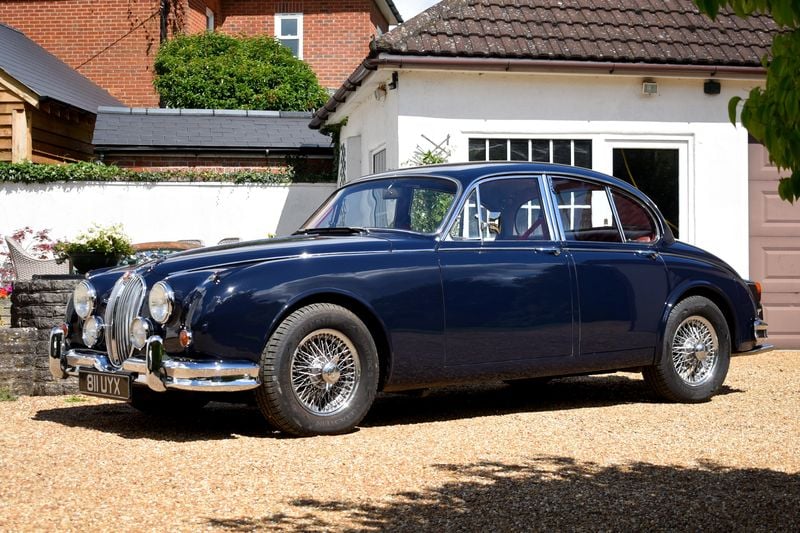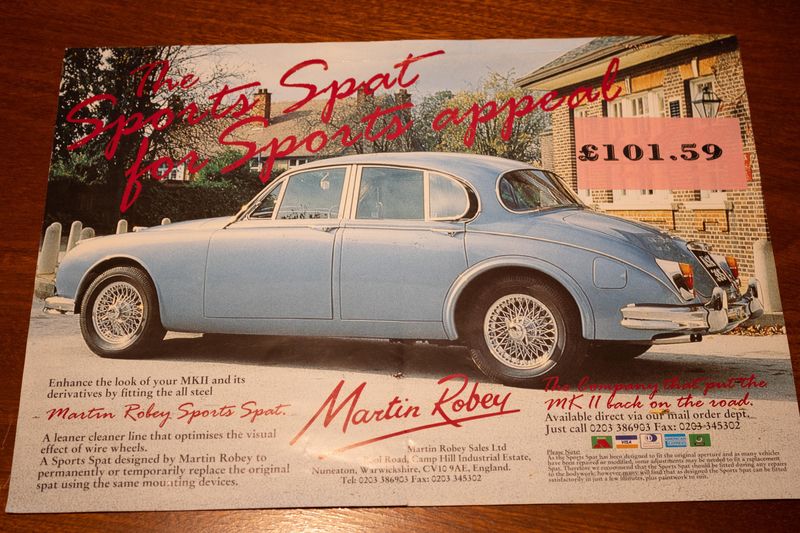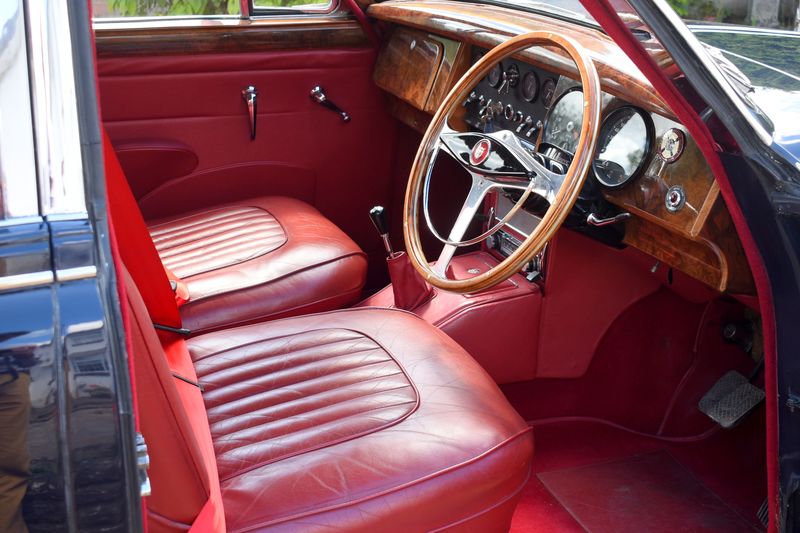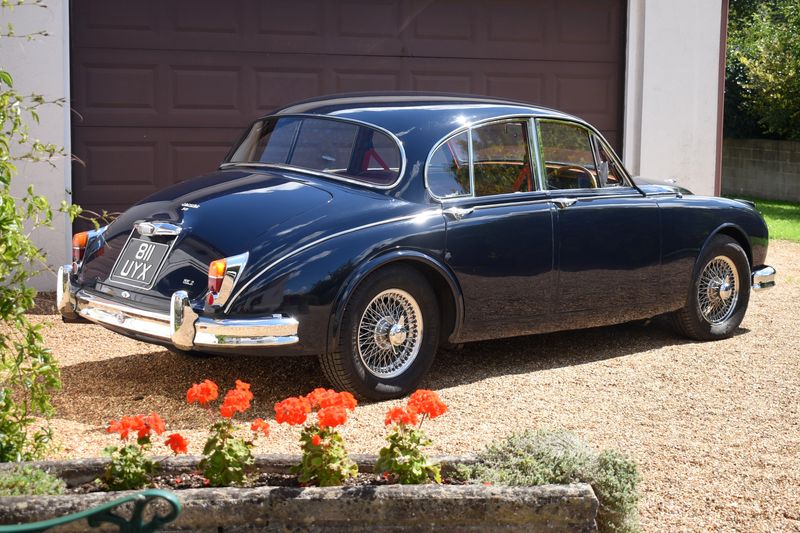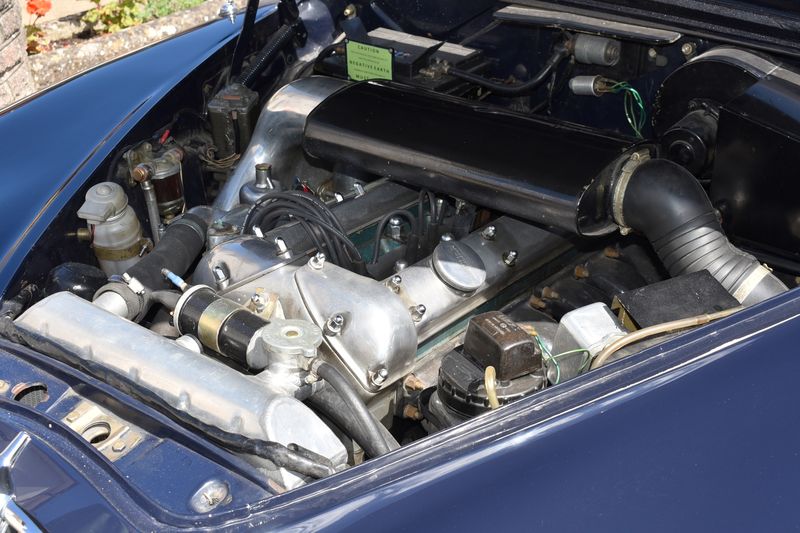Highlights
- Very early example from the first three months of production
- Recently restored over 200 hours to ‘better than new’ condition
- Bodywork has never been welded
- Sparingly used since engine rebuild
- Fitted with power steering and overdrive, plus multiple modern refinements
- Fresh MOT with no advisories
The Appeal
Few classic saloons enjoy a legacy quite like the Jaguar Mk. II. Ever since its launch in 1959, it’s always had an appreciative following, helped along the way by its dramatic and often victorious racing drives in the heyday of the British Saloon Car Championship, not to mention numerous film and television appearances.
Whether as the tyre-squealing steed of gangland villains in films such as Robbery and Get Carter, or as D.C.I. Morse’s elegant and refined transport around Oxford, the Mk. II has left a deep impression on thousands of enthusiasts’ hearts and minds.
Whether as the tyre-squealing steed of gangland villains in films such as Robbery and Get Carter, or as D.C.I. Morse’s elegant and refined transport around Oxford, the Mk. II has left a deep impression on thousands of enthusiasts’ hearts and minds.
While the Mk. II had only minor visual differences from the preceding Mk. I, it benefitted from a number of technical upgrades which made it one of the most sophisticated cars of its day. Jaguar was well ahead of most other manufacturers in introducing four-wheel disc brakes as standard.
The Mk. II also gained the recently introduced 3.8-litre engine, the largest version of the XK d.o.h.c. six and, naturally, it was the 3.8 which was the big motor-racing star, notably winning the 1962 and 1963 Australian Saloon Car Championships, the 1963 European Touring Car Challenge and the 1963 Brands Hatch Six Hours. Additional refinements included optional power-steering and overdrive, both of which are to be found on the car offered for sale.
The Mk. II also gained the recently introduced 3.8-litre engine, the largest version of the XK d.o.h.c. six and, naturally, it was the 3.8 which was the big motor-racing star, notably winning the 1962 and 1963 Australian Saloon Car Championships, the 1963 European Touring Car Challenge and the 1963 Brands Hatch Six Hours. Additional refinements included optional power-steering and overdrive, both of which are to be found on the car offered for sale.
This beautiful example is not just an extremely early 3.8 with all the trimmings. It is also, we are sure, one of the best in existence from an owner-driver perspective. It benefits from a recent restoration plus a few sensible deviations from original specification which make it a far better car under modern driving conditions. For the sort of enthusiast who likes to get the best out of a classic, there can’t be anything better than this.
The History and Paperwork
- Chassis P210675BW, first registered in January 1960, was built within the first three months of the Mk. II being launched
- Originally finished in Mist Grey with a Red interior, it was built for export to America
- The first owner was a Californian who is believed to have retained it until 1989, when it was sold to an owner in Northern Ireland who used it for various shows and rallies throughout the 1990s
- We believe the Jaguar returned to the British mainland in 2017, when it was reregistered with the D.V.L.A.
- The previous owner drove the car to Monaco and back once, but otherwise kept in storage
- The vendor bought it as a freshly restored car in 2021 but, sadly, health reasons force its sale
- It is offered for sale with the current V5 and a large collection of documents from its time in America and Ireland, including invoices, test certificates and commemorative show plaques dating back to the mid-1980s. A letter from Jaguar Cars Exports Limited confirms some of its early history.
- Fresh MOT with no advisories
The Interior
- Fully restored to original specification
- Converted to right-hand drive
- Some very rare early features
- Modern seatbelts installed for safety
- Very well-appointed, even including the original radio
There’s a lot of truth in the saying that ‘they don’t make things like they used to’. Contemporary thinking seems to be that a saloon is not a sports saloon unless it has a hard ride, hard seats and a generally austere interior, with maybe a bit of decorative carbon fibre trim to reinforce the message. This was not Jaguar’s approach in the 1950s, but the Mk. II is a bona fide sports saloon which handles as well as it accelerates and could sit all day at 100mph.
We just happen to think it’s a nice thing that, when you’re driving from London to Edinburgh, you can do so in luxury. The sumptuous leather seats let the driver enjoy armchair-like comfort, and the rich walnut veneer is a feast for the eyes.
Correspondence from Arthur J. Faro, the Californian who owned the Jaguar in the 1980s, confirms that the interior was renovated during his ownership with new headlining, carpets and upholstery, all remaining true to the original design. We believe that all you now see dates from Mr. Faro’s time, with everything in an excellent state of preservation having obviously seen only light use.
The seats are in excellent condition with no faults that we could see. The leather is just mellowing, assuming a most attractive character. The headlining and carpets are similarly immaculate, again with no faults which have come to our notice, and the walnut dash presents superbly, with an appropriately mellow shine.
Enthusiasts will be pleased to note that this car comes with some very distinctive features which were only fitted to very early cars, including the recessed sun visors and 100psi oil-gauge. We are advised that when, for reasons of economy, Jaguar switched to installing 60psi gauges, owners of earlier cars were invited to have theirs changed under warranty, so the fact that this retains its original 100psi gauge makes it rather special. There’s an interesting and collectible little piece of automobilia in the plaque from the Tourist Trophy Garage, the Farnham garage famously run by Leslie and Mike Hawthorn, although it does not reflect the car’s original destination.
Since arriving in Britain, the car has been converted to right-hand drive and an aftermarket Derrington steering wheel, a desirable period accessory, has been fitted.. For obvious safety benefits, modern seatbelts have been fitted but, since they match the upholstery, they remain inconspicuous. During the restoration, the car also received new heater pipes to the rear passenger area. The boot space is extremely clean and contains a spare wheel in very good condition.
The Exterior
- Repainted to a high standard in an original Jaguar colour
- Understood never to have been welded
- Coombs rear arches fitted but original spats supplied
- LED lights
- Small details such as the original clock still working as they should
Following its recent restoration, this Mk. II is in outstanding condition. The respray in Indigo Blue, an original Jaguar colour, is as good as it looks in the pictures, and from the condition of the chrome, we think it is evident that it was all or mostly replated around the same time. The Jaguar is presented very much for driving rather than concours but, even so, we think the paint and chrome are as good as can reasonably expected on a car that isn’t treated as a show queen.
Some people tell horror stories of buying a car which looked superb, only to get underneath it and find held together by chicken wire and papier maché. You may cast your fears aside. This Jaguar, the vendor assures us, has never been welded and has obviously never needed to be. Such is the advantage of buying a car which spent the first 30 years of its life in a dry California climate. Care has been taken to protect its condition, too, with the underside having received a liberal application of stone-chip protector to ensure it lasts well. Furthermore, says the vendor, “The doors open like on a new car.”
Keen Jaguar enthusiasts will have noted the desirable Coombs steel arches, of the type fitted to the Mk. IIs tuned by racing driver John Coombs, which experienced so much success in saloon-car racing. These, combined with the wire wheels, lend it a particularly sporty feel, although the original wheel-arch spats are included should they be more to your tastes. One additional but extremely subtle deviation from standard is the use of LED lights, which have obvious practical benefits.
The Mechanics
- Only 32,000 miles since 1980s engine rebuild
- 3.8-litre engine, power steering and overdrive – the most desirable specification
- Multiple discreet upgrades to improve reliability and the driving experience
For the enthusiast who likes to drive their classics, this Mk. II has it all. With its lusty, twin-SU-fed straight-six, it has all the soulful character that we love in old cars, but many subtle and thoughtfully-considered upgrades make it a practical choice for modern road use. The engine now benefits from a modern SU fuel pump, electronic ignition, aluminium radiator and stainless-steel exhaust pipe. The engine, as mentioned was rebuilt in America in the 1980s and, having only been lightly used since, remains in very good health.
The suspension received particular attention during the recent restoration. It received brand-new springs at all four wheels, so it sits at the correct ride height, and adjustable Koni shock absorbers have been used for enhanced comfort. Needless to say, all the suspension bushes were renewed, as were the gear-change bushes and track rod end gaiters. The electrics have been converted to negative earth to facilitate the use of a modern radio and satellite-navigation.
Another feature peculiar to the earliest Mk. IIs is the air intake system which pulls in air from near the fog lights. The vendor says, “It makes the engine extremely quiet, so you can’t hear it with overdrive in top.”
The vendor has fitted broader tyres for improved road-holding which, he says, present no challenge when manoeuvring at low speeds on account of the power steering.
Bidders will be advised that there is a slight weep of power-steering fluid, but the vendor adds, “Other than that, I can’t fault it.”
Bidders will be advised that there is a slight weep of power-steering fluid, but the vendor adds, “Other than that, I can’t fault it.”
The Summary
The Jaguar Mk. II is rightly celebrated for its luxury, performance and handsome styling and, with the 3.8 engine, power steering and overdrive, this example represents it at its very best. The recent restoration has been respectful of its history and originality while sagely taking advantage of certain technological developments to make it ideally suited to modern use.
With its excellent specification and sporty appearance courtesy of wire wheels and Coombs arches, it seems to us like it could be the day-to-day transport of a gentleman racing driver –cravat, driving gloves, B.R.D.C. blazer and all the rest. It’s the ideal car for Goodwood, driving tours and short runs out for a pub lunch – the opportunities to enjoy it are endless.
Notice to bidders
This item is sold on an ‘As is Where is’ basis. The condition of this item is the opinion of the seller and may differ from your own opinion. Photos and listing descriptions are for guidance purposes only*.** Car & Classic do not warrant listing accuracy. Full inspection is recommended. Viewings are at the seller’s discretion. Buyer is responsible for delivery and collection of any item purchased.*
UK-registered cars and motorbikes on Car & Classic are run through an online HPI check. On the HPI report, this vehicle shows no insurance database markers for damage or theft. It is currently not covered by a finance agreement.
UK-registered cars and motorbikes on Car & Classic are run through an online HPI check. On the HPI report, this vehicle shows no insurance database markers for damage or theft. It is currently not covered by a finance agreement.
A non-refundable buyer’s deposit is payable on this item, refer to FAQs and T&Cs for the applicable percentage.
All bidding, buying and offers are subject to our Terms and Conditions.

